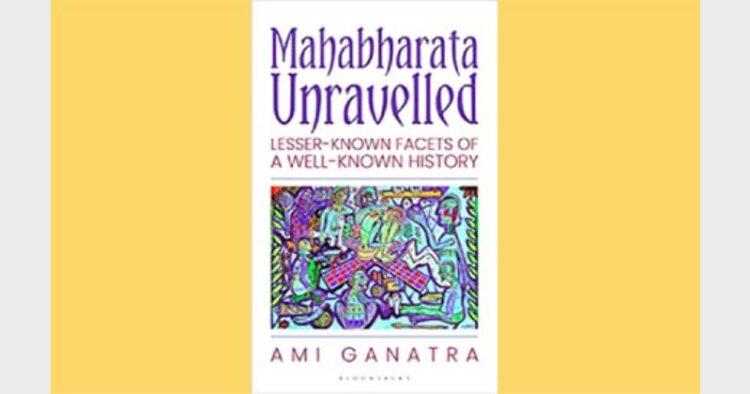Mahabharata Unravelled Lesser-Known Facets of A Well-Known History; Publication: Bloomsbury, Pp 373 , Rs 599.00
The Mahabharata is the largest epic of the world, and it has been the bedrock of Indian civilisation. This epic fascinates every reader, and due to the millennia that have passed by since the events that jolted the entire Bharatvarsha, a lot of characters have been romanticised and exaggerated by us. A lot of people from the current generation have had their first encounter with the Mahabharata from BR Chopra’s Mahabharata TV series. Although the TV series did a great job of making people aware of Mahabharata, it has interpreted some characters in a way that doesn’t resonate with the actual epic.
Ami Ganatra has tried to convey through the Mahabharata Unravelled to bust the myths associated with characters and incidents of Mahabharata by taking help from authentic sources like Bhandarkar Oriental Research Institute (BORI) and Gita Press.
The book starts with the explanation of the concepts of “itihasa” and “mythology”. It explains how the epic has been portrayed as “mythology” but actually an “itihasa”. It defines “dharma” as a word we colloquially use for religion, but the author has tried to explain that it means a lot more than that by the use of very simplistic words which can be understood easily. The author has tried to touch upon many topics which are generally unknown to the general public, who mostly are familiar with the Mahabharata by BR Chopra’s TV series, like the first public recital of the epic by Rishi Vaishampayana to Janamjeya (great-grandson of Arjuna). The author has dedicated a chapter to Bharata Vamsa and by the help of a family tree makes it easier for the reader to connect all the Bharata Vamsis to their ancestor, which in an epic as huge as the Mahabharata is a bit complex thing to do. There is a popular perception among the Indians that the southern part of India was never associated with the epic but the book, in its third chapter, which deals with the geographical coverage of the Mahabharata war, makes it clear that all the parts of erstwhile Bharatavarsha were associated with the epic. Generally, whenever we talk about the Mahabharata, we restrict it to the Mahabharata war, but the epic starts much before the war and ends much after it and has more than just the Mahabharata war as its content. The author has tried to touch upon these aspects in chapters like The Prodigal Sons, which deals with the sons of Pandavas and the Post-war Hastinapur Days. The book also explained concepts like akshauhini and niyoga, which have been used in the epic, but generally, we possess very little knowledge about them.
The book starts with explaining the concepts of “itihasa” and “mythology”. It describes how the epic has been portrayed as “mythology” but actually an “itihasa”. It defines “dharma” as a word we colloquially use for religion, but the author has tried to explain that it means a lot more than that by the use of very simplistic words which can be understood easily
The best part about the book is its objectivity in analysing the epic characters, which have been either eulogised or demonised due to the wrong interpretations. One of the main misunderstood characters of the Mahabharata is Draupadi. After watching BR Chopra’s Mahabharata, many common people held Draupadi responsible for the “Kurukshetra war” stating that she insulted Duryodhana by saying, “Andhe ka beta Andha”. But after reading this book, one gets a clear picture that there is no such incident mentioned in the original work. Karna, another character who has been eulogised beyond any extent stating that he belonged to a so-called “low caste” community and that Guru Dronacharya did not teach him just because of his caste. However, these myths and the myth that he was a great friend are busted in this book by citing examples such as the war between Gandharvas and Kauravas, which proves that only Karna’s jealousy against Arjuna motivated him to fight against Pandavas and not any bond of friendship. The book has tried to bring in meanings and explanations to words that we had been using, like the ten names of Arjuna and their meanings. There have been misconceptions about the Varna system and its mention in Mahabharata; however, the mention of the Nahusha episode and the conversation between Yudhisthira and Nahusha about “who is a Brahmin” clears the misconception that varna vyavastha was not a janm based system rather, it was a karm based system.
Overall the book is a great read for the people who have had encounters with the Mahabharata in one way or another. It can be a great revision as the book tries to summarise the epic in some three fifty-odd pages briefly. The language is simple and crisp, easy to understand without excessive verbal flourishes. The author reminds us consistently of the complexity and multi-dimensional aspects of the epic, things that have sustained interest for millennia. Compared to the relatively more idealistic world of the Ramayana, the Mahabharata has many aspects that still resonate in a contemporary, complex and depraved global scenario. The book can appeal to people who have just started to read the epics to someone who has a fair idea and is well-versed with the epics.














Comments